One hundred years after the founding of Bauhaus, it’s time to revisit bauhaus journal as significant written
testimony of this iconic movement of modern art.
-images and texts kindly provided by Lars Müller Publishers
Among the great number of books and articles that have appeared on the occasion of the Bauhaus centenary, and which testify to the continuing exploration and analysis of the school, the publication of a high-quality fascimile of the bauhaus journal represents a particularly valuable contribution that is able to inspire today’s readers. All the more so because it is accompanied for the first time by an English translation and is therefore able to reach an international audience, making the original, Bauhaus publication accessible not only to a German-speaking readership as a key primary source and reference work.
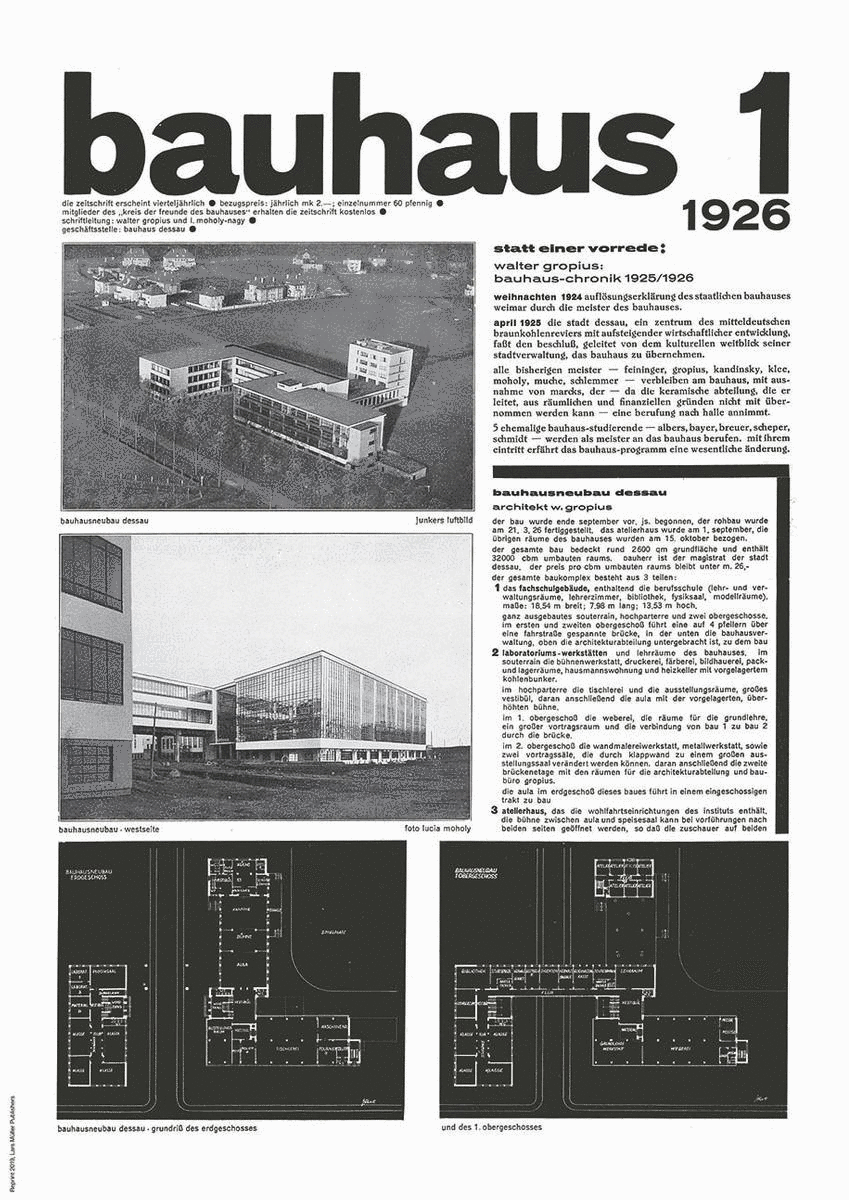
Bauhaus journal served as an important medium through which the movement communicated its image and identity, as well as thoughts and questions.
Published under the three successive directors of Bauhaus, Walter Gropius, Hannes Meyer and Ludwig Mies van der Rohe, and by a series of different editors (including Oskar Schlemmer,Ernst Kallai and Josef Albers) and designers (László Moholy-Nagy, Herbert Bayer and Joost Schmidt), the journal offers an insight into the Bauhaus artistic and political stances and controversies.
As Lars Müller publishers explain “The aim of this fascimile of the bauhaus journal is to better understand the roots of the twentieth-century avant-garde and the premises of modernism in order to be able to challenge and, if necessary, to overcome them.”
A century after its founding, the German school of art and architecture remains one of the most influential movements of the Modernist age. The Bauhaus movement championed a mix of raftsmanship with the arts in the service of architecture as well as a geometric, abstract style and no historical nods, and its aesthetic continues to influence architects, designers and artists until today.
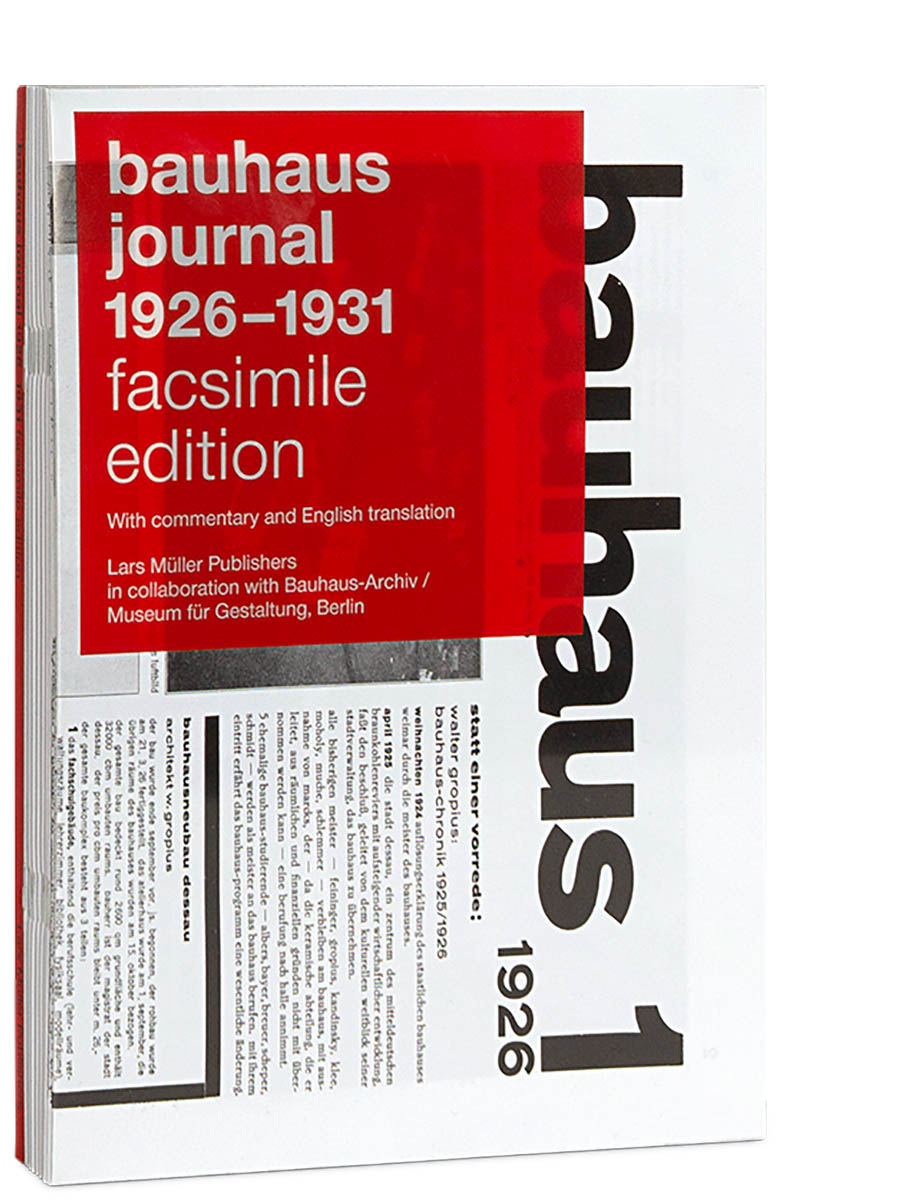
In this journal, published annually from 1926 to 1931, the most important voices of the movement are heard: masters of the Bauhaus, among others, Josef Albers, Walter Gropius, Wassily Kandinsky, Paul Klee, László Moholy-Nagy, and Oskar Schlemmer, as well as Herbert Bayer, Marcel Breuer, Ludwig Mies van der Rohe, Gerrit Rietveld, and many more.
The masters of the Bauhaus address the developments in and around the Bauhaus, the methods and focal points of their own teaching, and current projects of students and masters.
At the time primarily addressed to the members of the “circle of friends of the bauhaus,” the journal published by Gropius and Moholy-Nagy makes tangible the authentic voice of this mouthpiece of the avant-garde. The facsimile reprint is intended to give new impetus to international discussion and research on the Bauhaus, its theories and designs.
The exact replica of all individual issues are accompanied by a commentary booklet including an overview of the content, an English translation of all texts, and a scholarly essay which places the journal in its historical context.
Edited by Lars Müller in collaboration with Bauhaus-Archiv/Museum für Gestaltung, Berlin
With an essay by Astrid Bähr
With contributions by Josef Albers, Walter Gropius, Wassily Kandinsky, Paul Klee, László Moholy-Nagy, Oskar Schlemmer, Herbert Bayer, Marcel Breuer, Ludwig Mies van der Rohe, Gerrit Rietveld et al.
Design: Integral Lars Müller
21 × 29,7 cm, 8 ¼ × 11 ¾ in
412 pages, 702 illustrations
paperback, 14 issues with separate commentary (128 pages) and complete translation, in transparent slipcase
Lars Müller Publishers also reprinted Walter Gropius’ International Architecture (Bauhausbücher 1), Paul Klee’s Pedagogical Sketchbook (Bauhausbücher 2), Piet Mondrian’s New Design – Neoplasticism, Nieuwe Beelding (Bauhausbücher 5) and László Moholy-Nagy ‘ s Painting, Photography, Film (Bauhausbücher 8).

Walter Gropius, Bauhausbücher 1: INTERNATIONAL ARCHITECTURE
When the Bauhaus moved to Dessau in 1924, it was finally possible to publish the first of the Bauhausbücher that Walter Gropius (1883–1969) and Làszlò Moholy-Nagy (1895–1946) had first conceived of in Weimar. The series was intended to give insight into the teachings of the Bauhaus and the possibilities it offered for incorporating modern design into everyday aspects of an ever-more-modern world. First in the series was Gropius’ International Architecture, an overview of the modern architecture of the mid-1920s and an early attempt to articulate what would come to be known as International Style architecture. In a brief preface, Gropius summarized the guiding principles he identified uniting the avant-garde around the world. But the real thrust of the book is visual, with an extensive illustrated section showing buildings in Europe and the Americas. According to Gropius, these illustrations show the “development of a consistent worldview” that dispensed with the prior decorative role of architecture and expressed itself in a new language of exactitude, functionality and geometry.
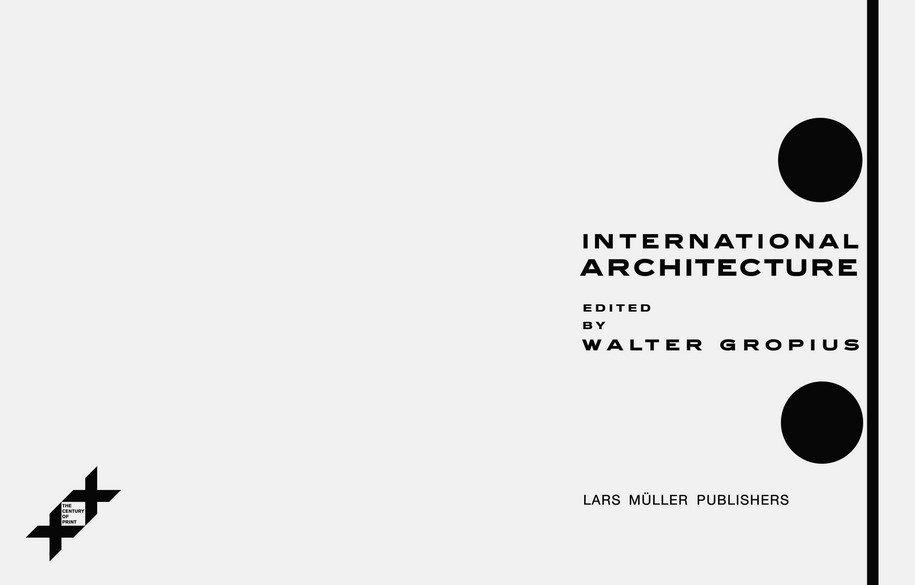 In what he called his “illustrated guide to modern architecture,” which starts off the Bauhausbücher series,
In what he called his “illustrated guide to modern architecture,” which starts off the Bauhausbücher series,
Gropius gives an overview of the international architecture of the mid-1920s. A preface by the author explores,
briefly but in detail, the guiding principles that unite the avant-garde in all countries. This statement is followed
by an extensive illustrated section showing examples of architecture from around the world. According to Gropius, these illustrations bear witness to the “development of a consistent worldview” that disposes of the
prior role of the architect and expresses itself in a new language of shapes.
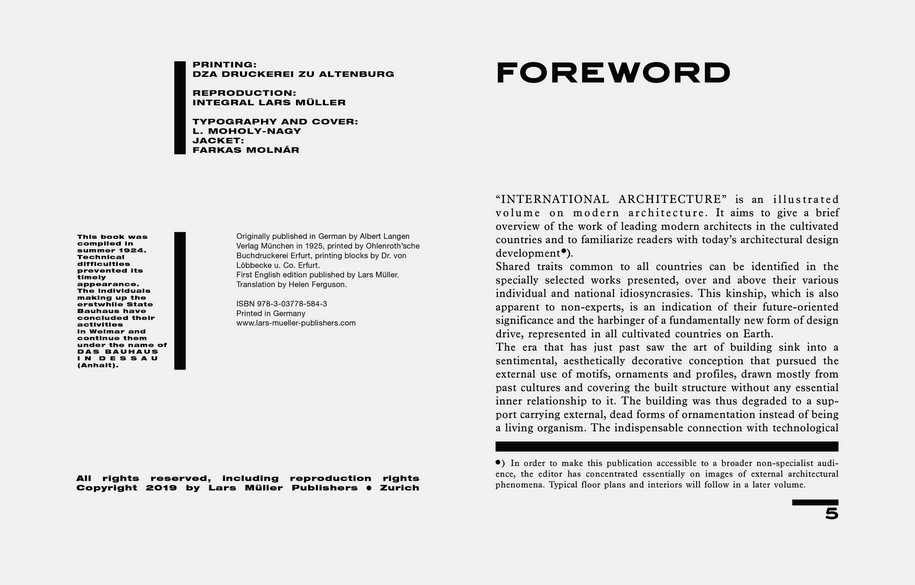
This first English edition of Volume 1 of the Bauhausbücher allows the reader to broaden his or her view of German architectural history by placing the achievements of the Bauhaus in an international context and by documenting and capturing its philosophy of reform in an illustrative way.
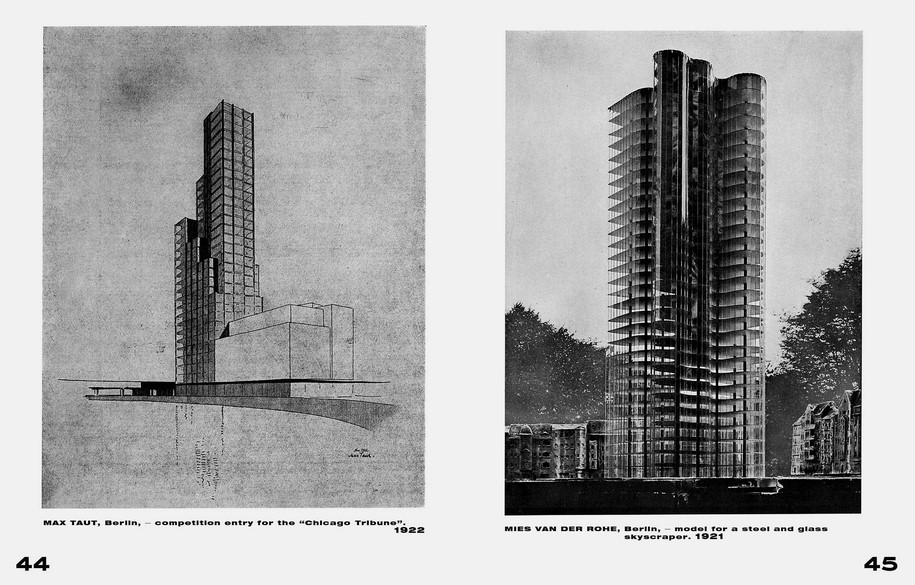
Walter Gropius (1888–1969) was the founder of the Bauhaus and a pioneer of modern architecture. In 1919, he
was appointed to succeed Henry van de Velde as director of the School of Visual Arts in Weimar, which he
renamed “Staatliches Bauhaus in Weimar”. In 1924, the Bauhaus moved to Dessau; Gropius designed the
school building and the masters’ houses for the new location. In 1928, Gropius passed on the title of director
to Swiss architect Hannes Meyer and became a self-employed architect in Berlin before emigrating to the
United States in 1934. As a professor of architecture, he taught at Harvard University in Cambridge,
Massachusetts, where he founded The Architects’ Collaborative in 1941.
Author(s): Walter Gropius
Edited by Walter Gropius, László Moholy-Nagy (original series), Lars Müller (facsimile edition) in collaboration with Bauhaus-Archiv/Museum für Gestaltung
Design: László Moholy-Nagy (original German edition)
18 × 23 cm, 7 × 9 in
108 pages, 100 illustrations
hardback
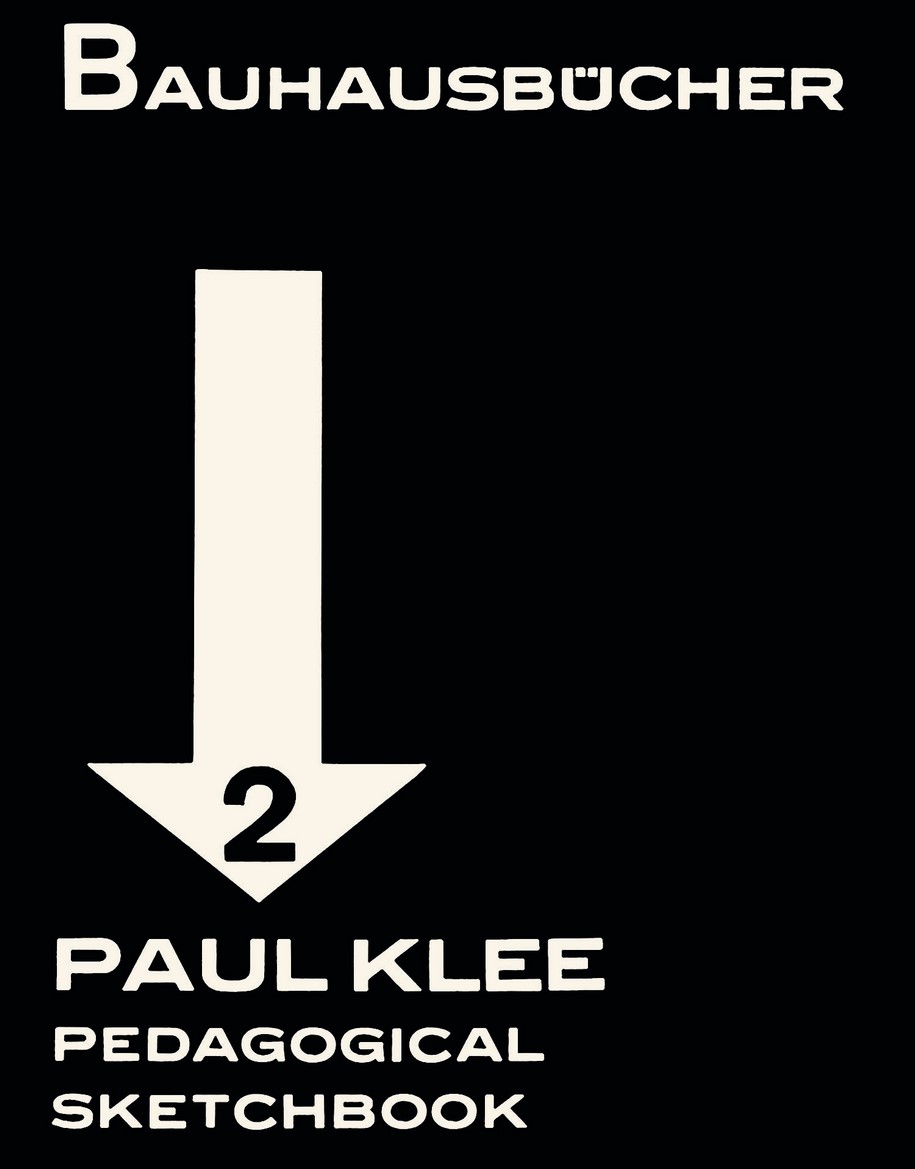
Paul Klee, Bauhausbücher 2: PEDAGOGICAL SKETCHBOOK
Active at the Bauhaus between 1920 and 1931, teaching in the bookbinding, stained glass and mural-painting
workshops, Paul Klee (1879–1940) brought his expressive blend of color and line to the school—and, with the
second volume in the Bauhausbücher series, beyond its walls.
In his legendary Pedagogical Sketchbook, Paul Klee takes a theoretical approach to drawing using geometric shapes and lines.
Evincing a desire to reunite artistic design and craft, and written in a tone that oscillates
between the seeming objectivity of the diagram, the rhetoric of science and mathematics, and an abstract,
quasi-mystical intuition, Klee’s text expresses key aspects of the Bauhaus’ pedagogy and guiding
philosophies. And while Klee’s method is deeply personal, in the context of the fundamentally multivocal
Bauhaus, his individual approach to abstract form is typical in its idiosyncrasy.
In this book, Paul Klee presents his own theory about the relationships between line, shape, surface, and color in the visual space.
In the present volume, the 1953 English translation by Sibyl Moholy-Nagy is combined with the design and
physical qualities of the original German edition from 1925.
Paul Klee (1879–1940) was a German painter and graphic artist. Prior to his influential work at the Bauhaus, he
was a member of the artists’ group Der Blaue Reiter. In 1914, while still working primarily as a draftsman and
graphic artist, he traveled to Tunis with two fellow artists; their journey is considered by art historians to be a
key event in German modern art. It was this journey that enabled Klee’s international breakthrough as a
painter. From 1920 to 1931, Klee was active at the Bauhaus until offered a professorship at the Art Academy in
Düsseldorf. After Hitler took power, Klee and his family emigrated to Bern. In 1937, numerous works of his
were displayed at the Degenerate Art exhibition, then confiscated and sold abroad. In 1940, about four months
prior to Klee’s death, the Kunsthaus Zürich hosted an anniversary exhibition of the artist’s later works. Paul
Klee’s extensive oeuvre and his writings on art theory make him one of the most important practitioners of
20th-century early modern art.
Author(s): Paul Klee
Edited by Walter Gropius, László Moholy-Nagy (original series), Lars Müller (facsimile edition) in collaboration with Bauhaus-Archiv/Museum für Gestaltung
Design: László Moholy-Nagy (original German edition)
18 × 23 cm, 7 × 9 in
56 pages, 87 illustrations
hardback
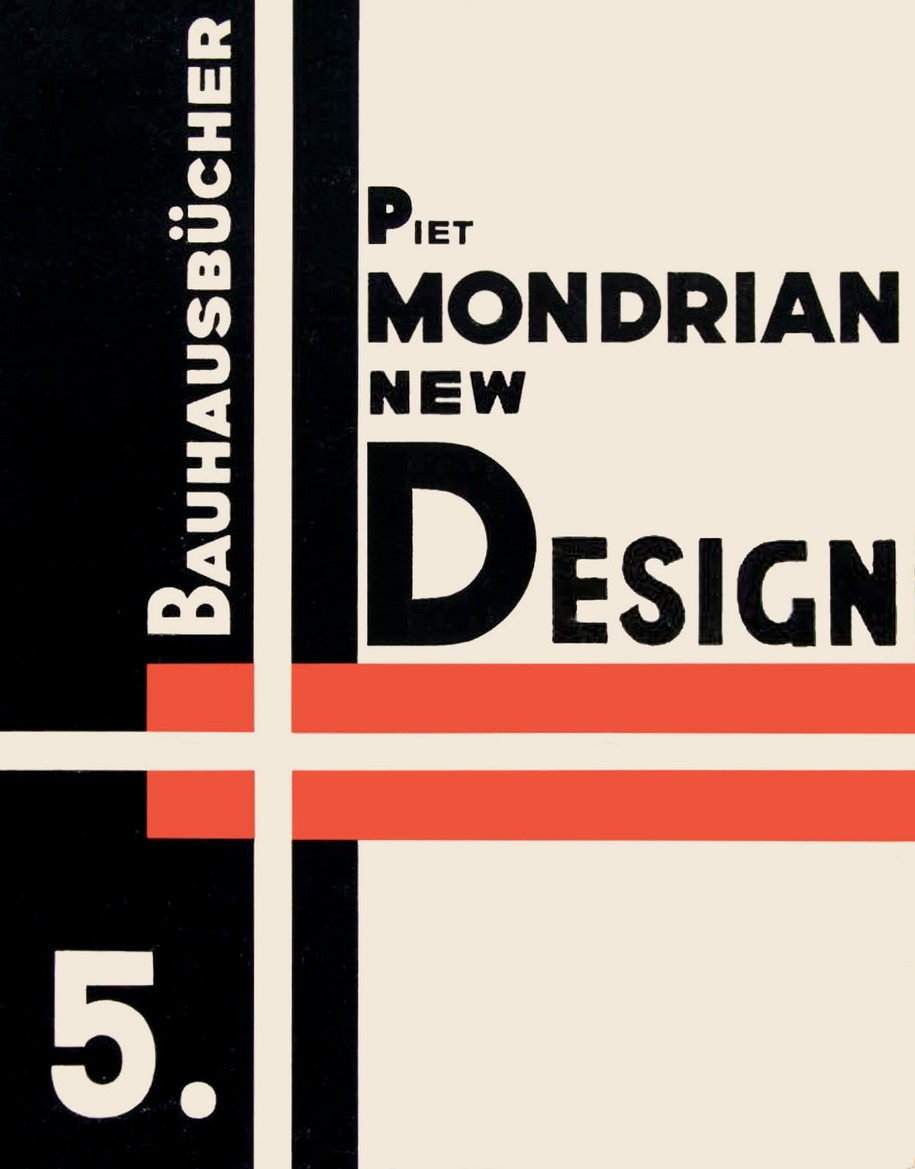
Piet Mondrian, Bauhausbücher 5: NEW DESIGN
Although Piet Mondrian was not an active member of the Bauhaus, his name is often mentioned in connection
with the art school. Starting with a philosophical foray in which he describes art as a figurative expression of
human existence, Mondrian embeds his concept of a New Design in the various forms of artistic expression.
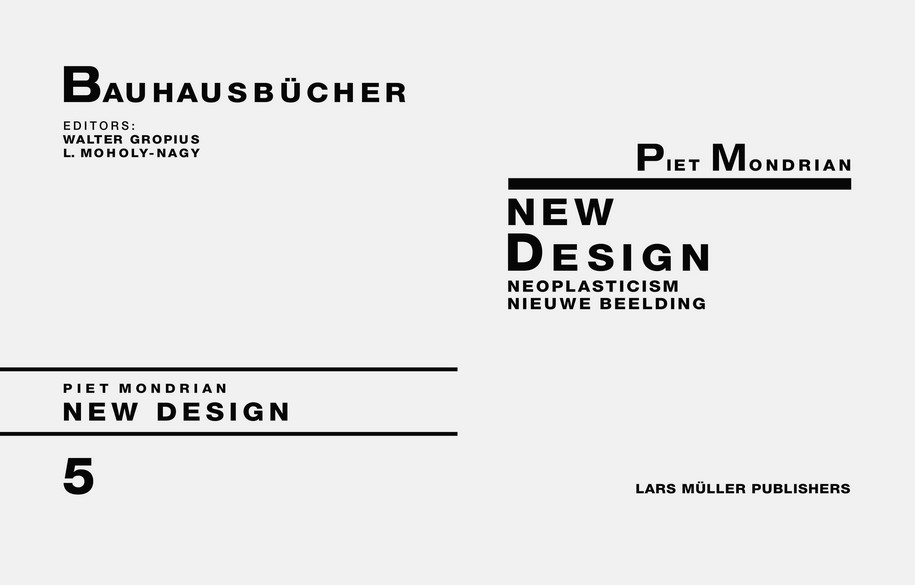
He looks into the question of whether there is a prevailing hierarchy between painting and architecture and
dares to take a far-reaching look at the future of neoplasticism.
This complete English edition appears in original design and with separate commentary.
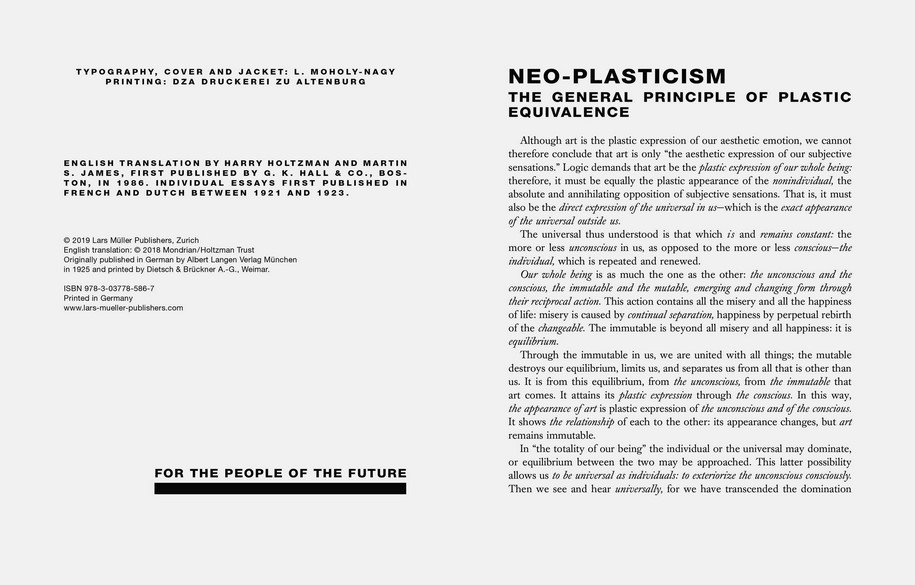
Piet Mondrian (1872–1944) was a Dutch painter who became known internationally as the founder of the De
Stijl artistic movement. Prior to touting neoplasticism in his writings on art theory, Mondrian encountered
cubism in Paris, his adopted home, which had a significant effect on his artistic work. His firm conviction of
abstract painting continued even after he emigrated to the United States in 1940, leading him to join the
American Abstract Artists in New York. Almost until his death, Mondrian continued to publish essays on art
theory in which he dealt intensively with neoplasticism and abstraction in painting.
Author(s): Piet Mondrian
Edited by Walter Gropius, László Moholy-Nagy (original series), Lars Müller (facsimile edition) in collaboration with Bauhaus-Archiv/Museum für Gestaltung
Design: László Moholy-Nagy (original German edition)
18 × 23 cm, 7 × 9 in
68 pages
hardback
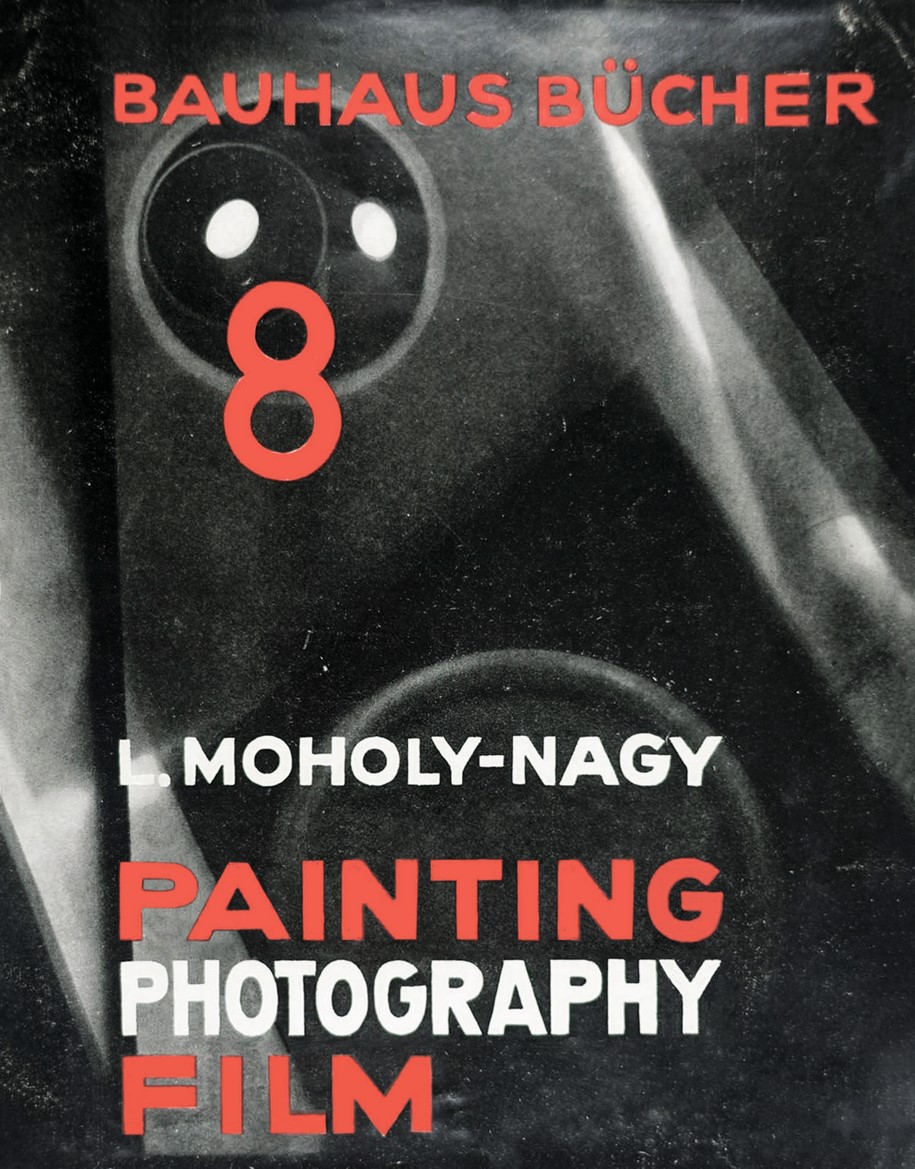
László Moholy-Nagy, Bauhausbücher 8: PAINTING, PHOTOGRAPHY, FILM
Moholy-Nagy’s efforts to have photography and filmmaking recognized as means of artistic design on the
same level as painting are propounded and explained at length. The use of artistic instruments is thus radically
reformed.

The Hungarian artist makes the case for a functional transformation within the visual arts and for the further development of photographic design options.
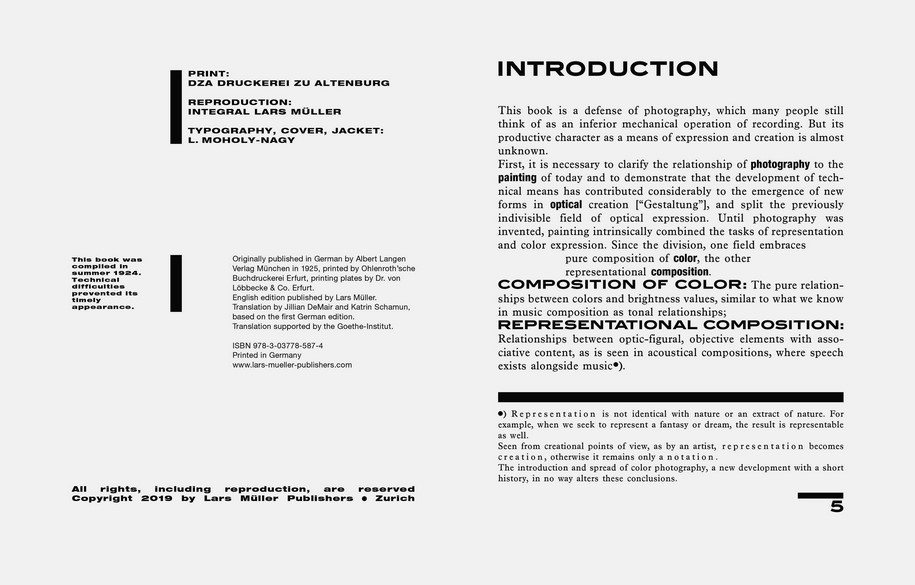
Alongside theoretical and technical approaches as well as detailed forays into the broad field of the medium of
photography, Moholy-Nagy uses an extensive appendix of illustrations to provide a thorough survey of the
numerous possibilities that photographic and cinematic work had in store as early as 1925.
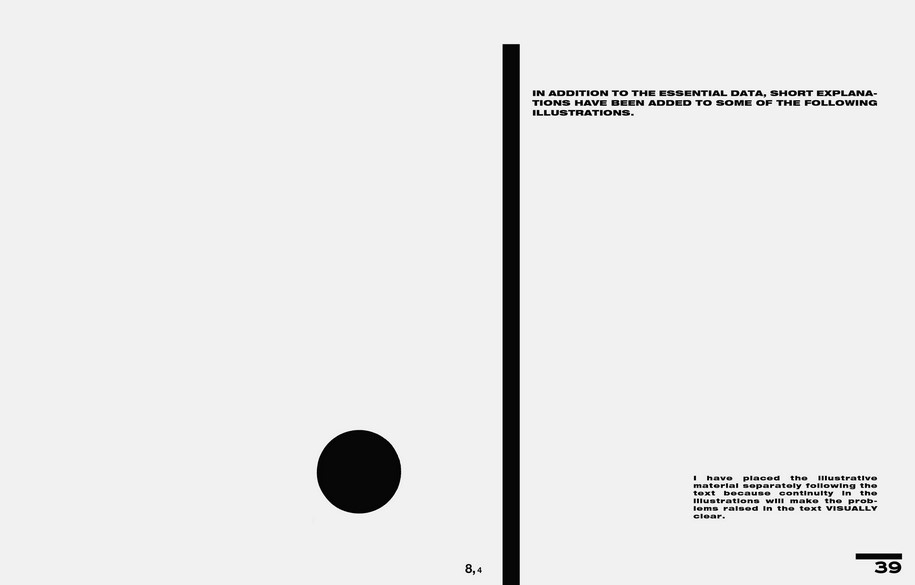
László Moholy-Nagy was born in southern Hungary in 1895. After unfinished law studies and military service
during the First World War, he attended an evening art school, which marked the beginning of his career as an
artist. During his first artistic years his style of art was much influenced and shifted from the figurative to a
short Dadaist phase before it became completely abstract. His earlier paintings, which were strongly
influenced by Russian Constructivism, already illustrate his life-long preoccupation with light and transparency.
Around 1922 Moholy-Nagy became aware of the photogram and the artistic potential of the motion picture,
which fascinated him for the rest of his life. When he moved to Berlin two years later, he met Walter Gropius,
director of the Bauhaus, who visited Moholy-Nagy’s exhibition at the avant-garde art gallery Der Sturm. He
appointed Moholy-Nagy as a teacher at the art school in Weimar in March 1923. The artist remained loyal to
the Bauhaus even after its move to Dessau, before he finally left it in 1928.
Author(s): László Moholy-Nagy
Edited by Walter Gropius, László Moholy-Nagy (original series), Lars Müller (facsimile edition) in collaboration with Bauhaus-Archiv/Museum für Gestaltung
Design: László Moholy-Nagy (original German edition)
18 × 23 cm, 7 × 9 in
134 pages, 100 illustrations
hardback
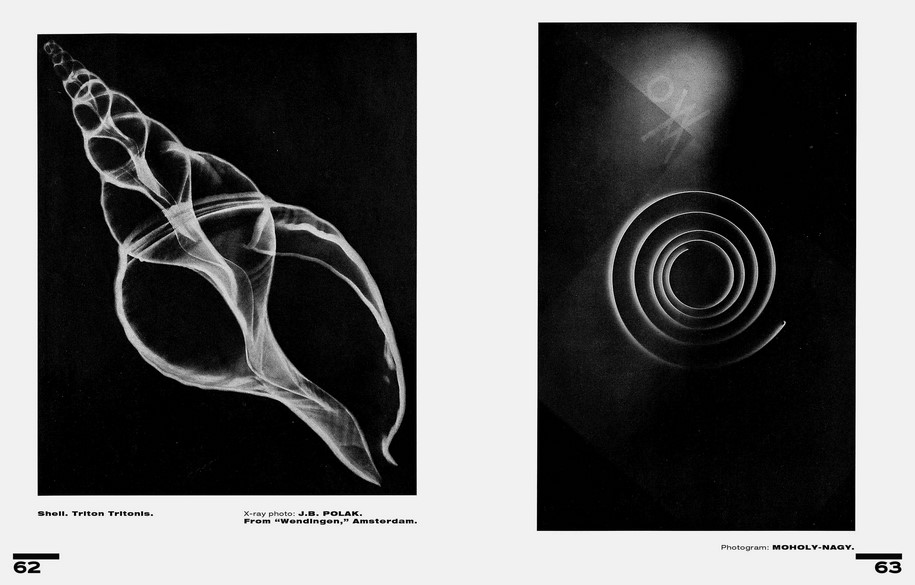
–
Εκατό χρόνια μετά την ίδρυση του Bauhaus, ήρθε η ώρα να επανεξετάσουμε το bauhaus journal (το περιοδικό «Μπαουχάους») ως μία σημαντική γραπτή μαρτυρία αυτού του εικονικού κινήματος της σύγχρονης τέχνης.
Σε αυτό το περιοδικό, που δημοσιεύεται από το 1926 έως το 1931, περιλαμβάνονται οι σημαντικότερες φωνές του κινήματος: οι δάσκαλοι του Bauhaus, μεταξύ άλλων, οι Josef Albers, Walter Gropius, Wassily Kandinsky, Paul Klee, László Moholy-Nagy και Oskar Schlemmer, καθώς και ο Herbert Bayer, ο Marcel Breuer, ο Ludwig Mies van der Rohe, ο Gerrit Rietveld και πολλοί άλλοι.
Οι δάσκαλοι του Bauhaus αναφέρονται στις εξελίξεις στο Bauhaus και γύρω από αυτό, στις μεθόδους και στα σημεία εστίασης της δικής τους διδασκαλίας, και τα τρέχοντα έργα σπουδαστών και δασκάλων.
Την εποχή εκείνη το περιοδικό, που εκδίδουν οι Gropius και Moholy-Nagy, απευθύνεται κατά κύριο λόγο στα μέλη του «κύκλου φίλων του bauhaus», και επιθυμεί να μεταφέρει την αυθεντική φωνή αυτού του ακροατηρίου της πρωτοπορίας. Η πανομοιότυπη εκτύπωση των τευχών αποσκοπεί να δώσει νέα ώθηση στη διεθνή συζήτηση και έρευνα σχετικά με το Bauhaus, τις θεωρίες και τα σχέδιά του.
Η επανέκδοση των Lars Müller Publishers περιλαμβάνει ένα ακριβές αντίγραφο όλων των επιμέρους τευχών και συνοδεύεται από ένα φυλλάδιο σχολιασμού που περιλαμβάνει μια επισκόπηση του περιεχομένου, μια αγγλική μετάφραση όλων των κειμένων και ένα επιστημονικό δοκίμιο που τοποθετεί το περιοδικό στο ιστορικό του πλαίσιο.
Walter Gropius, Bauhausbücher 1: ΔΙΕΘΝΗΣ ΑΡΧΙΤΕΚΤΟΝΙΚΗ
Σε αυτό που αποκαλούσε “εικονογραφημένο οδηγό για τη σύγχρονη αρχιτεκτονική”, και ξεκινάει από τη σειρά Bauhausbücher, ο Gropius δίνει μια γενική εικόνα της διεθνούς αρχιτεκτονικής στα μέσα της δεκαετίας του 1920.
Ένας πρόλογος από τον συγγραφέα διερευνά, εν συντομία αλλά λεπτομερώς, τις κατευθυντήριες αρχές που ενώνουν την avant-garde σε όλες τις χώρες.
Αυτή η δήλωση ακολουθείται από μια εκτεταμένη εικονογραφημένη ενότητα που δείχνει παραδείγματα αρχιτεκτονικής από όλο τον κόσμο. Σύμφωνα με τον Gropius, αυτά τα παραδείγματα μαρτυρούν την “ανάπτυξη μιας συνεπούς κοσμοθεωρίας” που διαθέτει ο προηγούμενος ρόλος του αρχιτέκτονα και εκφράζεται σε μια νέα γλώσσα μορφών.
Η πρώτη αυτή αγγλική έκδοση του Τόμου 1 του Bauhausbücher επιτρέπει στον αναγνώστη να διευρύνει την άποψή του για τη γερμανική αρχιτεκτονική ιστορία τοποθετώντας τα επιτεύγματα του Bauhaus σε διεθνές πλαίσιο και εγγράφοντας και καταγράφοντας την φιλοσοφία της μεταρρύθμισης με έναν επεξηγηματικό τρόπο.
Ο Walter Gropius (1888-1969) ήταν ο ιδρυτής του Bauhaus και πρωτοπόρος της σύγχρονης αρχιτεκτονικής. Το 1919, ο ίδιος διορίστηκε για να διαδεχθεί τον Henry van de Velde ως διευθυντής της Σχολής Εικαστικών Τεχνών στη Βαϊμάρη, την οποία και ο ίδιος μετονόμασε σε “Staatliches Bauhaus στη Βαϊμάρη”. Το 1924, η σχολή Bauhaus μετακόμισε στο Dessau. Ο Γκρόπιους σχεδίασε το σχολικό κτίριο και τις κατοικίες των δασκάλων στη νέα τοποθεσία. Το 1928, ο Gropius μεταβίβασε τον τίτλο του διευθυντή στον Ελβετό αρχιτέκτονα Hannes Meyer και παρέμεινε ανεξάρτητος αρχιτέκτονας στο Βερολίνο πριν μεταναστεύσει στις Ηνωμένες Πολιτείες το 1934. Ως καθηγητής αρχιτεκτονικής δίδαξε στο Πανεπιστήμιο του Harvard στο Cambridge, Massachusetts, όπου ίδρυσε τη Συνεργατική Αρχιτεκτονική (The Architects’ Collaborative) το 1941.
Paul Klee, Bauhausbücher 2: ΠΑΙΔΑΓΩΓΙΚΟ ΣΗΜΕΙΩΜΑΤΑΡΙΟ
Ενεργός στο Bauhaus μεταξύ 1920 και 1931, διδάσκοντας εργαστήρια βιβλιοδεσίας, βιτρό και τοιχογραφίας, ο Paul Klee (1879-1940) έφερε την εκφραστική μείξη του χρώματος και της γραμμής στη σχολή -και μαζί με το
δεύτερο τόμο στη σειρά Bauhausbücher.
Στο εμβληματικό του Παιδαγωγικό σημειωματάριο, ο Paul Klee κρατά μια θεωρητική προσέγγιση στο σχέδιο χρησιμοποιώντας γεωμετρικά σχήματα και γραμμές.
Προάγοντας την επιθυμία να επανασυνδεθεί ο καλλιτεχνικός σχεδιασμός με την τέχνη, και γραμμένο με έναν τόνο που κυμαίνεται μεταξύ της φαινομενικής αντικειμενικότητας του διαγράμματος, της ρητορικής της επιστήμης και των μαθηματικών και μιας αφηρημένης, σχεδόν-μυστικιστικής διαίσθησης, το κείμενο του Klee εκφράζει βασικές πτυχές της παιδαγωγικής και φιλοσοφίες καθοδήγησης του Bauhaus. Και ενώ η μέθοδος του Klee είναι βαθιά προσωπική, στο πλαίσιο της θεμελιωδώς πολυεθνικής διάστασης Bauhaus, η ατομική του προσέγγιση στην αφηρημένη μορφή είναι χαρακτηριστική στην ιδιοσυγκρασία του.
Σε αυτό το βιβλίο, ο Paul Klee παρουσιάζει τη δική του θεωρία σχετικά με τις σχέσεις μεταξύ γραμμής, σχήματος, επιφάνειας και χρώματος στον οπτικό χώρο.
Στον παραπάνω τόμο, η αγγλική μετάφραση του 1953 από τον Sibyl Moholy-Nagy συνδυάζεται με το σχεδιασμό και το
φυσικές ιδιότητες της αρχικής γερμανικής έκδοσης του 1925.
Ο Paul Klee (1879-1940) ήταν Γερμανός ζωγράφος και γραφίστας. Πριν από την επιρροή του έργο στο Bauhaus, ήταν μέλος της ομάδας καλλιτεχνών Der Blaue Reiter. Το 1914, ενώ εργαζόταν πρωτίστως ως γραφίστας, ταξίδεψε στην Τύνιδα με δύο συναδέλφους του και το ταξίδι τους θεωρείται από τους ιστορικούς της τέχνης ως το γεγονός κλειδί στη γερμανική σύγχρονη τέχνη. Ήταν αυτό το ταξίδι που συνέβαλε στη μεταστροφή του Klee ως ζωγράφου. Από το 1920 έως το 1931, ο Klee ήταν ενεργός στο Bauhaus μέχρι να του προσφερθεί η θέση καθηγητή στην Ακαδημία Τέχνης του Ντίσελντορφ. Μετά την ανάληψη της εξουσίας από τον Χίτλερ, ο Klee και η οικογένειά του μετανάστευσαν στη Βέρνη. Το 1937, πολλά έργα του προβλήθηκαν στην έκθεση Degenerate Art και στη συνέχεια κατασχέθηκαν και πωλήθηκαν στο εξωτερικό. Το 1940, περίπου τέσσερις μήνες πριν τον θάνατο του Klee, το Kunsthaus Zürich φιλοξένησε μια επετειακή έκθεση των μεταγενέστερων έργων του καλλιτέχνη. Το εκτεταμένο έργο του PaulKlee και τα κείμενα του για τη θεωρία της τέχνης τον καθιστούν έναν από τους σημαντικότερους ασκούμενους της πρώιμης σύγχρονης τέχνης του 20ού αιώνα.
Piet Mondrian, Bauhausbücher 5: ΝΕΟ DESIGN
Παρόλο που ο Piet Mondrian δεν ήταν ενεργό μέλος του Bauhaus, το όνομά του αναφέρεται συχνά σε σχέση με την σχολή τέχνης. Ξεκινώντας από μια φιλοσοφική διαδρομή, στην οποία περιγράφει την τέχνη ως μια εικονιστική έκφραση της ανθρώπινης ύπαρξης, ο Mondrian ενσωματώνει την έννοια του Νέου Σχεδίου στις διάφορες μορφές καλλιτεχνικής έκφρασης. Εξετάζει το ερώτημα αν υπάρχει επικρατούσα ιεραρχία ανάμεσα στη ζωγραφική και την αρχιτεκτονική, και τολμά να εξετάσει το μέλλον του νεοπλαστικισμού.
Ο Piet Mondrian(1872-1944) ήταν ένας Ολλανδός ζωγράφος που έγινε γνωστός διεθνώς ως ο ιδρυτής του καλλιτεχνικού κινήματος DeStijl. Η σταθερή του πεποίθηση για την αφηρημένη ζωγραφική συνέχισε ακόμα και μετά τη μετανάστευσή του στις Ηνωμένες Πολιτείες το 1940, οδηγώντας τον να συμμετάσχει στην ομάδα των Αμερικανών Αφηρημένων Καλλιτεχνών στη Νέα Υόρκη. Σχεδόν μέχρι το θάνατό του, ο Mondrian συνέχισε να δημοσιεύει δοκίμια σχετικά με τη θεωρία της τέχνης, στα οποία ασχολήθηκε έντονα με το νεοπλαστικισμό και την αφαίρεση στη ζωγραφική.
László Moholy-Nagy, Bauhausbücher 8: ΖΩΓΡΑΦΙΚΗ, ΦΩΤΟΓΡΑΦΙΑ, ΦΙΛΜ
Σε αυτή τη σειρά, παρουσιάζονται και εξηγούνται εκτενώς οι προσπάθειες του Moholy-Nagy για να αναγνωριστεί η φωτογραφία και η κινηματογραφική παραγωγή ως μέσο καλλιτεχνικού σχεδιασμού στο ίδιο επίπεδο όπως και η ζωγραφική. Η χρήση των καλλιτεχνικών μέσων αλλάζει έτσι ριζικά.
Ο Ούγγρος καλλιτέχνης κάνει λόγο για μια λειτουργική μεταστροφή μέσα στις εικαστικές τέχνες και για την περαιτέρω ανάπτυξη της φωτογραφίας. Παράλληλα με τις θεωρητικές και τεχνικές προσεγγίσεις, καθώς και τις λεπτομερείς εξελίξεις στο ευρύ πεδίο του μέσου, ο Moholy-Nagy χρησιμοποιεί ένα εκτεταμένο παράρτημα εικονογραφήσεων για να δώσει μια εμπεριστατωμένη έρευνα για τις διάφορες δυνατότητες που είχε το φωτογραφικό και κινηματογραφικό έργο ήδη από το 1925.
Ο László Moholy-Nagy γεννήθηκε στη νότια Ουγγαρία το 1895. Μετά από ημιτελείς νομικές σπουδές και στρατιωτικές υπηρεσίες κατά τον Πρώτο Παγκόσμιο Πόλεμο, παρακολούθησε μία νυχτερινή σχολή τέχνης, η οποία σημάδεψε την αρχή της καριέρας του ως καλλιτέχνη. Κατά τη διάρκεια των πρώτων καλλιτεχνικών του χρόνων, το ύφος της τέχνης του επηρεάστηκε και μετατοπίστηκε πολύ από την εικονογραφική έως την πρωτοποριακή φάση του Dadaist πριν γίνει τελείως αφηρημένη. Τα προηγούμενα έργα του, τα οποία επηρεάστηκαν έντονα από το ρωσικό κονστρουκτιβισμό, απεικονίζουν ήδη τη διαχρονική του ανησυχία με το φως και τη διαφάνεια. Το 1922 ο Moholy-Nagy γνώρισε το φωτόγραμμα και την καλλιτεχνική δυνατότητα της κινούμενης εικόνας, που τον γοήτευε για την υπόλοιπη ζωή του. Όταν μετακόμισε στο Βερολίνο δύο χρόνια αργότερα, συνάντησε τον Walter Gropius, διευθυντή του Bauhaus, κατά την επίσκεψη του τελευταίου στην έκθεση του Moholy-Nagy, στην πρωτοποριακή γκαλερί τέχνης Der Sturm. Ο Moholy-Nagy, ορίστηκε δάσκαλος της Σχολής Καλών Τεχνών στη Βαϊμάρη το Μάρτιο του 1923. Ο καλλιτέχνης παρέμεινε πιστός στο Bauhaus ακόμα και μετά τη μετακίνησή του στο Dessau, πριν το εγκαταλείψει τελικά το 1928.
READ ALSO: ARP architects completed APS House in Antiparos, Greece